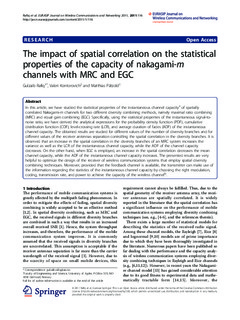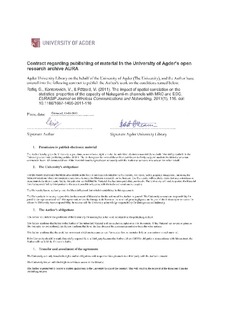| dc.contributor.author | Rafiq, Gulzaib | |
| dc.contributor.author | Kontorovich, Valeri | |
| dc.contributor.author | Pätzold, Matthias | |
| dc.date.accessioned | 2011-12-13T11:38:16Z | |
| dc.date.available | 2011-12-13T11:38:16Z | |
| dc.date.issued | 2011 | |
| dc.identifier.citation | Rafiq, G., Kontorovich, V., & Pätzold, M. (2011). The impact of spatial correlation on the statistical properties of the capacity of Nakagami-m channels with MRC and EGC. EURASIP Journal on Wireless Communications and Networking, 2011(1), 116. doi: 10.1186/1687-1499-2011-116 | no_NO |
| dc.identifier.issn | 1687-1499 | |
| dc.identifier.uri | http://hdl.handle.net/11250/137917 | |
| dc.description | Published version of an article published in the journal: EURASIP Journal on Wireless Communications and Networking. Also available from the publisher at: http://dx.doi.org/10.1186/1687-1499-2011-116. OA | no_NO |
| dc.description.abstract | In this article, we have studied the statistical properties of the instantaneous channel capacitya of spatially correlated Nakagami-m channels for two different diversity combining methods, namely maximal ratio combining (MRC) and equal gain combining (EGC). Specifically, using the statistical properties of the instantaneous signal-to-noise ratio, we have derived the analytical expressions for the probability density function (PDF), cumulative distribution function (CDF), level-crossing rate (LCR), and average duration of fades (ADF) of the instantaneous channel capacity. The obtained results are studied for different values of the number of diversity branches and for different values of the receiver antennas separation controlling the spatial correlation in the diversity branches. It is observed that an increase in the spatial correlation in the diversity branches of an MRC system increases the variance as well as the LCR of the instantaneous channel capacity, while the ADF of the channel capacity decreases. On the other hand, when EGC is employed, an increase in the spatial correlation decreases the mean channel capacity, while the ADF of the instantaneous channel capacity increases. The presented results are very helpful to optimize the design of the receiver of wireless communication systems that employ spatial diversity combining techniques. Moreover, provided that the feedback channel is available, the transmitter can make use of the information regarding the statistics of the instantaneous channel capacity by choosing the right modulation, coding, transmission rate, and power to achieve the capacity of the wireless channel b. | no_NO |
| dc.language.iso | eng | no_NO |
| dc.publisher | Springer | no_NO |
| dc.title | The impact of spatial correlation on the statistical properties of the capacity of Nakagami-m channels with MRC and EGC | no_NO |
| dc.type | Journal article | no_NO |
| dc.type | Peer reviewed | no_NO |
| dc.subject.nsi | VDP::Technology: 500::Information and communication technology: 550::Telecommunication: 552 | no_NO |
| dc.source.pagenumber | 1-12 | no_NO |
| dc.source.volume | 2011 | no_NO |
| dc.source.journal | EURASIP Journal on Wireless Communications and Networking | no_NO |

